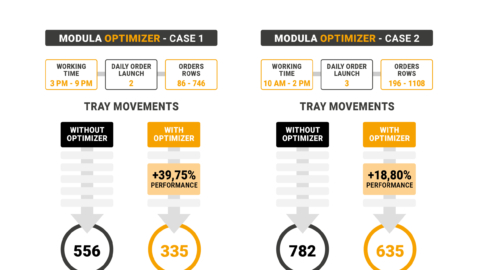We can regard stock management models as useful rules of engagement in the scheduling of procurement or production activities. In practice, these are simplified representations of real scenarios which demonstrate how to solve operational problems in our businesses. These are useful examples of how to approach operational problems scientifically, study our own operational reality and finally produce specific models which we can actually use.
The purpose of this article is to bring together essential information about individual stock management models. A full description of how each of these models works is developed in a separate article.
Contents of this article:
- Introduction to stocks
- Stock management models for items in constant demand
- The case of known constant demand: Wilson model
- Order point and fixed interval management models: differences and how to choose
- MRP (Material Requirement Planning)
- JIT (Just in Time)
- What is the perfect quantity of goods to keep in stock?
1. Product stocks: what do I need and how do I manage them efficiently
Stock management comes under the scope of systems which control the flow of materials within the logistics/production process and its aim is to minimise the cost of holding products in the warehouse whilst ensuring these are fed correctly into production flows and sales streams.
By stock we mean a certain quantity of an item accumulated in order to be placed at the disposal of a user for consumption according to their needs. Stock is like a buffer which creates a flexible link between phases in the production process which may be adjacent but which may have different operating frequencies. For example, supplies of raw materials are periodic whilst their use in production is constant.
Having stocks ensures that materials are available in order to reduce the order/delivery cycle time, continuity of upstream/downstream processes and reduction in the risk of running out of stock. This is where people talk of stock coverage when items are immediately available for delivery to clients.
Other than serving the above functions, stocks can also be used for speculative purposes like, for example, taking investment opportunities and controlling a product’s price.
Within a distribution system, we can identify different stock sub-types:
- Stock in transit (or travelling): stocks currently loaded on to transport vehicles
- Deposited stock
- Cyclical stock: stocks linked to different operating frequencies between two immediately adjacent phases of the logistics chain. This allows processes to be disconnected
- Safety stock: stocks required to cover any variability in demand and/or resupply lead time
- Speculative stock, Strategic stock, Dead stock
Stock management policy covers the control of material flows, but which materials? It seems appropriate to make a distinction between:
- demand for independent stock: this refers to stocks of required materials for which the requested quantities are not related to the consumption of any others but simply depend on market demand (e.g. stocks of spare parts);
- demand for dependent stock: the requested quantity is linked to downstream consumption by the logistics/production process in question. Obviously these materials can also be part of independent demand if the products are sold directly.
For more information on this subject, please read this article: How to manage stock effectively
There are many different stock management models. In this article we will not be analysing them all, but will content ourselves with the ones which will probably provide you with the most answers to your problems.
2. Stock management models for items in constant demand
The simplest scenario is the one the stock manager is able to solve by reordering goods in regular demand. These products, as you can guess, require periodic reordering throughout the year, and so there is no particular model needed for their management.
However, one problem that you may encounter in this scenario is being able to manage the storage of these items so that you know their quantity and location at any time and keep the condition of this material under control. To find out what the most efficient solution for your storage needs might be, you can read our article for more information: Items in constant demand: models for stock management and tools for storing them
3. The case of known constant demand: Wilson model
The Wilson model can be used when we know either what quantities to order or the time interval between one order and the next as these remain constant. Under this model, the only significant costs to consider when determining the quantities to be ordered are as follows:
- cost of ordering (directly proportional to the number of orders issued)
- cost of holding (which increases according to the number of resupply lots but is inversely proportional to the number of orders)
In order to know the quantity, you need to express an objective function and understand at what value per lot the total cost of ordering and holding is minimised.
Once you know the quantity, you can then proceed to define very simply how many orders there will be and the rotation time.
For more information about this model: Wilson model for inventory management: known constant demand.
4. Order point and fixed interval management models: differences and how to choose
These two stock management models are part of the traditional probabilistic models and feature the following main characteristics:
- demand is independent
- responds to constant goods scenarios
- parameters do not vary over time
- at least one parameter is random
The base assumption for both of these models is as follows: demand is a random Gaussian variable (RV) where the supplier lead time is known and constant.
It is therefore not possible to issue reorders for constant quantities at mostly constant intervals, but you will need to choose between:
- Management by order point: constant quantities are reordered each time available stocks reach the established order point
- Management by fixed interval: variable quantities are ordered at established fixed intervals
Which of these two models do I choose? Read this article to find out what are the three issues to keep in mind when you have to choose between these two models: Order point and fixed interval management models: differences and how to choose
5. MRP system: how to calculate material requirements?
Material Requirement Planning MRP is the material requirement planning model used in the manufacture of finished products. It is used to plan production and procurement orders, taking into account market demand, bill of materials and production lead times.
This system is preferable to order point and fixed interval systems as it involves lower stock levels and does not require accurate predictions.
The limits of the MRP system are mainly linked to the difficulties businesses have collecting the necessary information and keeping it constantly up-to-date. To get around this problem, you can use automatic vertical tray warehouses equipped with WMS which enable you to keep track of all materials stored inside the warehouse, making a Just In Time inventory a practical reality.
For more information on the MRP system and integrating it with automatic vertical warehouses: MRP system: how to calculate material requirements?
6. Just In Time or no-waste manufacturing
Just like MRP, this management system has been specifically designed to manage products with dependent demand, such as raw materials and component
parts in a manufacturing company whose demand “depends” on demand for the finished product. Just In Time is a production management methodology which allows you to limit held stock, or in some cases eliminate it altogether.
Moving from the Just In Time “philosophy” to its practical application within a company is not easy, so we have explored it in more detail in this article: Just In Time or no-waste manufacturing
7. What is the perfect quantity of goods to keep in stock?
Irrespective of the model used, this is the question everyone asks themselves and no one knows the right answer to. We often tend to overestimate the quantity of material ordered without considering the costs of managing this stock and any specific objectives for which we need to keep a certain amount of stock.
Before issuing the order, you need to obtain a series of information about outputs, inputs and constraints linked to the management and organisation of your business.
In this article What is the perfect quantity of goods to keep in stock? we try to provide an answer to this question.
Ideas for warehouse reorganization



